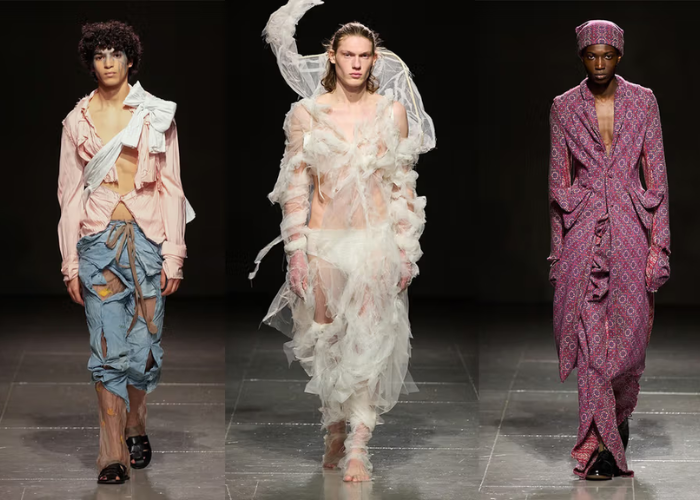
In the realm of human expression, few forms of artistic creation captivate the senses and stimulate the imagination quite like haute couture. The term “haute couture” conjures images of meticulously crafted garments, opulent fabrics, and runway extravaganzas. Yet, beyond the glamorous surface lies a deeper narrative, an intricate symphony of artistry, craftsmanship, history, and identity. This article delves into the enchanting world of couture, exploring the multidimensional layers that compose its artistic harmony.
The Evolution of Couture: A Historical Prelude
Couture, derived from the French word couturier meaning dressmaker, finds its origins in the mid-19th century. The birthplace of couture was Paris, a city already celebrated for its cultural richness. The first couturier, Charles Frederick Worth, established the principles that would shape the industry’s future. He introduced the concept of presenting collections to clients, marking a shift from individually tailored garments to a more standardized yet still exclusive process. This marked the beginning of fashion houses, where a designer’s vision is presented through seasonal collections.
Over the decades, couture evolved to embrace innovation and changing societal norms. Designers like Coco Chanel challenged conventions, liberating women from corsets and introducing practicality into haute couture. This fusion of tradition and innovation laid the groundwork for the sartorial symphonies that would follow.
The Artisan’s Overture: Craftsmanship and Technique
At the heart of couture lies an unparalleled dedication to craftsmanship. Each piece is meticulously crafted by artisans who possess an exceptional mastery of their craft. From pattern-making to sewing, beading, and embroidery, every step is executed with precision and devotion. It can take hundreds of hours to complete a single garment, as designers and artisans collaborate to bring a vision to life.
One of the defining features of couture is the emphasis on handwork. Techniques passed down through generations are combined with contemporary approaches, creating a harmonious blend of tradition and modernity. Embroidery, for instance, transforms fabric into a canvas for intricate stories. Beads, sequins, and thread interlace to create textures that resonate with emotions, offering a tactile experience that transcends the visual.
Fabric as Melody: The Role of Textiles
In the symphony of couture, fabrics play the role of melody. Just as a composer selects instruments to convey specific emotions, couturiers choose textiles that harmonize with their creative intent. Luxurious silks, sumptuous velvets, delicate lace, and opulent brocades are among the instruments couture designers use to compose their narratives.
The journey to find the perfect fabric is often a tale of exploration. Textiles are chosen not only for their visual and tactile qualities but also for the stories they carry. The intricate patterns of traditional Japanese kimono fabrics, the regal history of Scottish tartan, or the delicate artistry of Indian silk all contribute to the symphonic tapestry of couture.
The Designer’s Sonata: Vision and Inspiration
In the world of couture, the designer’s vision is the guiding melody. Each collection tells a story, often deeply personal or inspired by historical, cultural, or artistic references. The designer’s ability to translate abstract concepts into tangible garments is akin to a composer’s skill in translating emotions into musical notes.
The design process is a symphony in itself. It begins with inspiration, which can be found in nature, art, literature, and more. Then comes the sketching phase, where ideas take shape on paper. These sketches evolve into patterns, which become prototypes before evolving into the final garments. Like a composer arranging notes, the designer orchestrates each detail, from silhouette and color to embellishment and texture, until the ensemble is a harmonious whole.
The Catwalk Concerto: Runways as Grand Stages
The runway show is the crescendo of the couture symphony. Just as a symphony needs a stage to come to life, couture creations need the runway to be fully appreciated. The runway show is more than a display of garments; it’s a carefully choreographed performance that captures the essence of the collection.
Fashion shows transport the audience into the designer’s world. Elaborate sets, lighting, and music enhance the experience, enveloping viewers in the story the designer wishes to tell. The pacing of the show, the order in which garments are presented, and the models who wear them all contribute to the narrative’s depth. The runway becomes a stage where couturiers invite the audience to immerse themselves in their artistic vision.
Couture as Identity: The Personal Symphony
Couture is more than just clothing; it’s a form of self-expression and identity. Just as music can be deeply personal, couture garments resonate with the wearer’s individuality. When an individual dons a couture creation, they become part of the symphony, their unique presence enhancing the collective harmony.
Celebrities often become the embodiments of couture’s artistic narratives, gracing red carpets and events in one-of-a-kind ensembles. These garments not only reflect the wearer’s personal style but also tell a story that extends beyond fashion. Through couture, individuals can express their values, aspirations, and cultural affiliations.
Sustainability and the Future of Couture
As the world shifts towards sustainability, the couture industry is also embracing change. The symphony of couture is adapting its notes to resonate with ethical and environmental concerns. Designers are exploring eco-friendly textiles, responsible production practices, and upcycling techniques, infusing new meaning into the art form.
In this evolving movement, the symphony of couture continues to harmonize tradition, innovation, and sustainability. Just as music evolves with each generation, so does couture, ensuring its relevance and resonance in an ever-changing world.
Conclusion
Couture is not merely about clothing; it’s about storytelling, craftsmanship, and personal expression. It’s an intricate symphony that brings together designers, artisans, fabrics, and wearers into a harmonious composition. With every collection, every stitch, and every runway show, the world of couture adds new movements to its symphony, celebrating the past while embracing the future.
Like a symphony that transcends time and culture, couture speaks a universal language that resonates with emotions, aspirations, and human creativity. It’s an everlasting ode to the artistic spirit that continually inspires us to create, innovate, and harmonize our lives with beauty. Just as a symphony captures the essence of human experiences, couture encapsulates the essence of our identities, aspirations, and dreams, weaving them into an unforgettable melody that reverberates through time.






